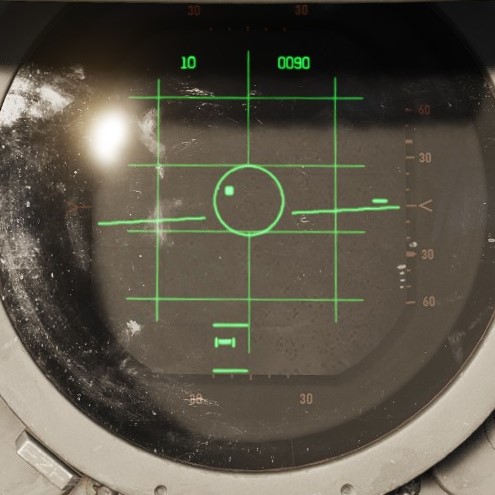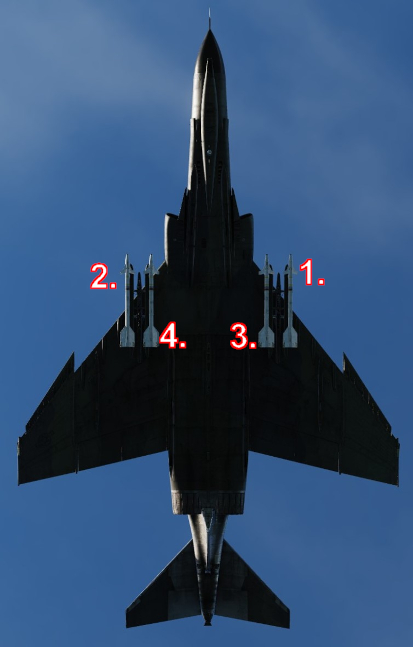AIM-9 Sidewinder

Entering service with the United States Navy in 1956, and finally accepted by the United States Air Force in 1964, the short range, infrared seeking AIM-9 Sidewinder is considered by most to be the world's first truly effective air to air guided missile. Beginning with the AIM-9B and maintaining compatibility to the AIM-9M in US service, the Sidewinder provided the Phantom II with a capable close-in weapon system against rapidly maneuvering opponents.
Employment
Employment of the AIM-9 can be performed with or without a radar lock, and is initiated by selecting Master Arm to ON and selecting the Throttle Pinky Switch to the center position for Heat. The HEAT lamp on the Head Up Display will illuminate, and available AIM-9 missiles will illuminate on the Missile Status Panel. The Optical Sight should be selected to A/A, and the reticle will stabilize at the Radar Boresight Line, which is the boresight location for the Sidewinders on the rails.
Should a radar lock be achieved, the sight will display the range bar on the right side as previously described, with 20,000' indicated at the top, and 3,000' range indicated at the bottom. With a radar lock on, the radar will display a pair of strobes signifying Rmax and Rmin for the Sidewinder against the target under current launch conditions.

💡 The AIM-9 does not receive a guidance handoff from the APQ-120 like on later aircraft to direct the seeker's look angle. Instead, the ASE circle presents the aim dot against the target to bring it to the RBL.
Centering the aim dot in the ASE aligns the target to the RBL, thus allowing for rapid acquisition by the seeker of the selected AIM-9. Once the missile's tone changes to signify lock, the pilot can then hold down the ARR button on the grip to allow for Sidewinder self-track (seeker uncage); this function allows the seeker to maintain acquisition of the target (noted by the shifted audio tone), while permitting maneuver of the aircraft to a better aspect angle or range solution prior to launch if the situation allows. The amount of maneuver available to a given Sidewinder type is based on the variant, and should be considered before making the selection.
Launch Sequence

Once the desired firing solution is attained, the AIM-9 is launched using the trigger.
AIM-9 Launch Sequence:
- Left Outboard
- Right Outboard
- Left Inboard
- Right Inboard
Variants
The following variants of the AIM-9 family are available for this variant of the Phantom:
| Variant | Description |
|---|---|
| B | First operational version of the Sidewinder family, entering service in the 1950s. It utilized an infrared homing seeker for target acquisition and tracking, making it a heat-seeking missile. |
| J | Featuring enhanced guidance and performance characteristics. It retained the infrared homing seeker but had improved sensitivity and better resistance to countermeasures. |
| JULI | Variant of the AIM-9J developed by Germany. It featured modifications to meet specific operational requirements. |
| L | Significant upgrade with improved infrared homing capabilities, allowing for better target discrimination. It introduced all-aspect targeting, meaning it could engage targets from any angle, not just from behind. |
| M | Improved guidance and counter-countermeasures capabilities. It had enhanced maneuverability and improved target-tracking algorithms, making it more effective in combat situations. |
| P | Developed for export and used by various nations. It featured improvements over earlier models in terms of reliability and seeker performance. |
| P-3 | Improves the P version by using a reduced-smoke motor and improving the guidance system. Base of the swedish RB-24J missile. |
| P-5 | Further improves counter-countermeasures capabilities, as seen in the M version. Base of the swedish RB-24L missile. |
| Captive M | Non-functional version used for training and testing purposes. |
Below is a basic comparative summary of each Sidewinder's performance in some general areas, whereas 🟢 means good, 🟨 fair and 🔺 poor.
| Type | Lock-Tone | Uncage | Aspect | Maneuverability | CM Resist | Motor |
|---|---|---|---|---|---|---|
| B | 🔺 | 🔺 | Rear | 🔺 | 🔺 | 🔺 |
| J | 🔺 | 🟢 | Rear | 🟨 | 🟨 | 🔺 |
| JULI | 🟢 | 🟢 | All | 🟨 | 🟢 | 🟨 |
| L | 🟢 | 🟢 | All | 🟢 | 🟢 | 🟢 |
| M | 🟢 | 🟢 | All | 🟢 | 🟢 | 🟢 |
| P | 🔺 | 🟢 | Rear | 🟨 | 🟨 | 🔺 |
| P-3 | 🔺 | 🟢 | Rear | 🟨 | 🟨 | 🟨 |
| P-5 | 🟢 | 🟢 | All | 🟨 | 🟢 | 🟨 |
| Captive M | 🟢 | 🟢 | All | ❌ | 🟢 | ❌ |
Some variants have a null-seeker. These missiles do not produce a tone when fully aligned with a target. This can lead to confusion, thinking the missile does not track while it is actually locked perfectly on the target.
The AIM-9B is unable to uncage in order to dynamically track a target that is not on its boresight.
Smokewinders
For airshows, the aircraft can also be equipped with Smoke Generators fitted inside Sidewinder dummies, called Smokewinders.

The generator activates or deactivates the smoke upon receiving a Weapon Release signal. That is, select HEAT, MASTER ARM and then pull the trigger.
Available smoke colors are red, green, blue, white, yellow and orange.